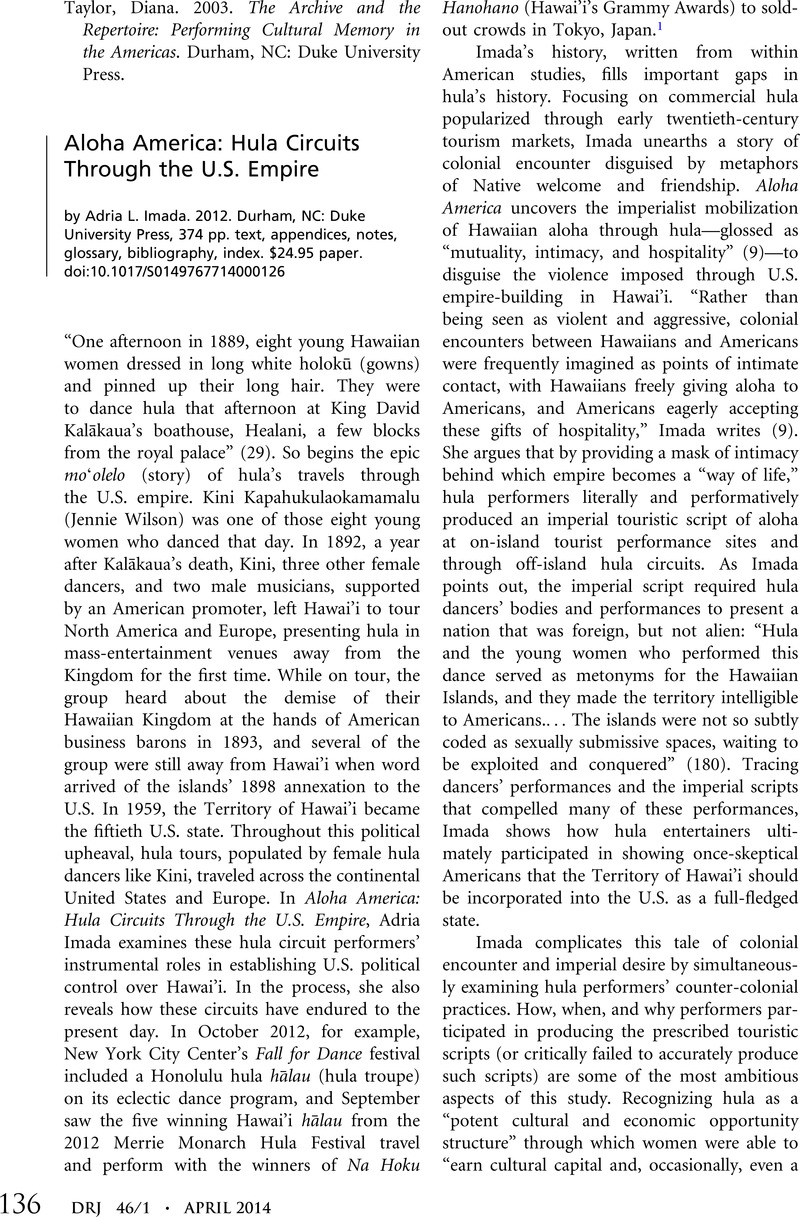No CrossRef data available.
Article contents
Aloha America: Hula Circuits Through the U.S. Empire by Adria L. Imada. 2012. Durham, NC: Duke University Press, 374 pp. text, appendices, notes, glossary, bibliography, index. $24.95 paper.
Published online by Cambridge University Press: 25 June 2014
Abstract
An abstract is not available for this content so a preview has been provided. Please use the Get access link above for information on how to access this content.

- Type
- Book Reviews
- Information
- Copyright
- Copyright © Congress on Research in Dance 2014
References
Works Cited
Buck, Elizabeth. 1994. Paradise Remade: The Politics of Culture and History in Hawaii. Philadelphia: Temple University Press.Google Scholar
Desmond, Jane. 1997. “Invoking ‘The Native’: Body Politics in Contemporary Hawaiian Tourist Shows.” TDR 41(4): 83–109.CrossRefGoogle Scholar
Desmond, Jane. 1999. Staging Tourism: Bodies on Display from Waikiki to Sea World. Chicago: University of Chicago Press.Google Scholar
Foster, Susan Leigh. 1996. Corporealities: Dancing Knowledge, Culture and Power. London: Routledge.Google Scholar
“Hula Fest Returns to Japan.” 2012. http://www.yomiuri.co.jp/dy/features/arts/T120725003434.htm. Daily Yomiuri Online. (In Japanese.) Accessed November 25, 2012.Google Scholar
Imada, Adria. 2004. “Hawaiians on Tour: Hula Circuits through the American Empire.” American Quarterly 56(1): 111–49.Google Scholar
Kaeppler, Adrienne. 1993. Hula Pahu: Hawaiian Drum Dances: Ha'a and Hula Pahu Sacred Movements. Honolulu: Bishop Museum Press.Google Scholar
Kameʻ elihiwa, Lilikalā. 1992. Native Land and Foreign Desires: A History of Land Tenure Change in Hawai'i from Traditional Times Until the 1848 Māhele, Including an Analysis of Hawaiian Aliʻi Nui and American Calvinists. Honolulu: Bishop Museum Press.Google Scholar
Macaulay, Alistair. 2012. “Indian Fusion and Traditional Hula.” The New York Times online edition, October 8. http://www.nytimes.com/2012/10/09/arts/dance/fall-for-dance-at-city-center-with-hawaiian-and-indian-work.html (accessed November 25, 2012).Google Scholar
Osorio, Jonathan. 2002. Dismembering Lāhui: A History of the Hawaiian Nation to 1887. Honolulu: University of Hawaiʻi Press.Google Scholar
Shea Murphy, Jacqueline. 2007. The People Have Never Stopped Dancing: Native American Modern Dance Histories. Minneapolis, MN: University of Minnesota Press.Google Scholar
Silva, Noenoe. 2004. Aloha Betrayed: Native Hawaiian Resistance to American Colonialism. Durham, NC: Duke University Press.Google Scholar
Smith, Linda Tuhiwai. 1999. Decolonizing Methodologies: Research and Indigenous Peoples. London: Zed Books Ltd.Google Scholar
Taylor, Diana. 2003. The Archive and the Repertoire: Performing Cultural Memory in the Americas. Durham, NC: Duke University Press.Google Scholar
Teaiwa, Teresia K. 1994. “Bikinis and Other S/Pacific N/Oceans.” Contemporary Pacific 6(1): 87–109.Google Scholar
Trask, Haunani Kay. 1999. From a Native Daughter: Colonialism and Sovereignty in Hawaii. Honolulu: University of Hawaii Press.Google Scholar




